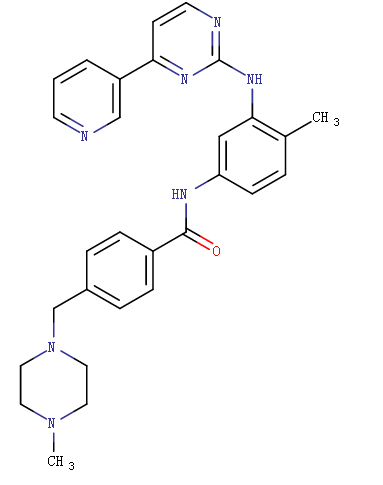Imatinib
Other name
Celonib (Celon) / Enliven (Orion) / Glivec (Novartis) / Imatib (Grey Inversiones) / Mesylonib (Miracalus) / Mitinab (Glenmark) / Plivatinib (Pliva) / Shantinib (Shantha)
International/Other brands
Gleevec
Groups
Approved
Structure

Prescription products
| Name | Dosage | Strength | Route | Labeller |
|---|---|---|---|---|
| Gleevec | Tablet | 100 mg/1 | Oral | Novartis Pharma Produktions Gmb H |
| Gleevec | Tablet | 100 mg | Oral | Novartis |
| Gleevec | Tablet | 100 mg/1 | Oral | Novartis |
| Gleevec | Capsule | 100 mg | Oral | Novartis |
| Gleevec | Tablet | 400 mg/1 | Oral | Novartis |
| Gleevec | Tablet | 100 mg/1 | Oral | Avera Mc Kennan Hospital |
| Gleevec | Tablet | 400 mg | Oral | Novartis |
| Glivec | Capsule | 100 mg | Oral | Novartis Europharm Limited |
| Glivec | Tablet, film coated | 400 mg | Oral | Novartis Europharm Limited |
Target
-
Description
Imatinib is a small molecule kinase inhibitor used to treat certain types of cancer. It is currently marketed by Novartis as Gleevec (USA) or Glivec (Europe/Australia) as its mesylate salt, imatinib mesilate (INN). It is occasionally referred to as CGP57148B or STI571 (especially in older publications). It is used in treating chronic myelogenous leukemia (CML), gastrointestinal stromal tumors (GISTs) and a number of other malignancies. It is the first member of a new class of agents that act by inhibiting particular tyrosine kinase enzymes, instead of non-specifically inhibiting rapidly dividing cells.
Indications
For the treatment of Philadelphia chromosome positive chronic myeloid leukemia (Ph+ CML), Ph+ acute lymphoblastic leukaemia, myelodysplastic/myeloproliferative diseases, aggressive systemic mastocytosis, hypereosinophilic syndrome and/or chronic eosinophilic leukemia (CEL), dermatofibrosarcoma protuberans, and malignant gastrointestinal stromal tumors (GIST).
Other indications
-
Mechaism of action
-
Absorption
The pharmacokinetics in CML and GIST patients are similar. Imatinib is well absorbed with mean absolute bioavailability is 98% and maximum plasma levels achieved within 2-4 hours of dosing
Metabolism
Primarily hepatic via CYP3A4. Other cytochrome P450 enzymes, such as CYP1A2, CYP2D6, CYP2C9, and CYP2C19, play a minor role in its metabolism. The main circulating active metabolite in humans is the N-demethylated piperazine derivative, formed predominantly by CYP3A4. This metabolite is similar in potency to the parent compound.
Toxicity
The most frequently reported adverse reactions (>30%) were edema, nausea, vomiting, muscle cramps, musculoskeletal pain, diarrhea, rash, fatigue and abdominal pain.